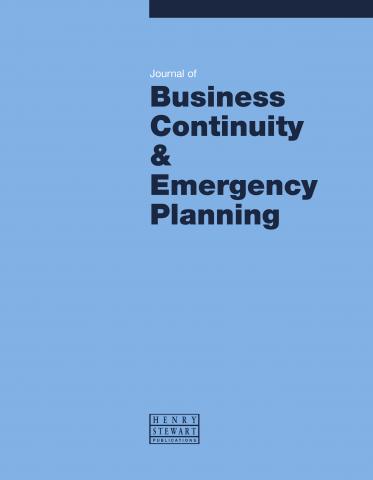"It's very exciting to see a peer-reviewed journal for our field. I'm impressed with the range of topics but also that the journal analyses emerging trends in all areas of advancement and communications. The quality of the articles I've seen so far is also very nice to see."
Volume 6 (2012-13)
Each volume of Journal of Business Continuity & Emergency Planning consists of four quarterly 100-page issues. The articles published in Volume 6 were:
Volume 6 Number 4
-
Preventing a data breach from becoming a disaster
Ed Goldberg, Business Continuity/Disaster Recovery Manager, Northeast Utilities -
Snow: Building a better all-hazards response
Peter Gaynor, Director, Providence Emergency Management Agency & Office of Homeland Security, City of Providence, Rhode Island -
Untangling the webs of global supply chains
Lee Glendon, Head of Research & Advocacy, Business Continuity Institute -
Winning strategies for the business community during the next pandemic
Martin Spriggs, Special Project Lead, Emergency/Disaster Management, Alberta Health Services -
Communicating and managing change during extreme weather events: New practices for responding to urgent and emergent climate threats
Timothy Tinker, Senior Associate, Booz Allen Hamilton -
Decision makers in crisis (management): Raising awareness on ‘soft factors’ to exploit mostly untapped resources
Alessandro Carone, Senior Manager, KPMG and Luigi Di Iorio, Business Consultant, Open Human Solutions -
Organizational performance and business continuity management: A theoretical perspective and a case study
Ihab Sawalha, Head and Acting Chairperson, Risk Management Department, American University of Madaba
Volume 6 Number 3
-
Identifying key tier one suppliers
Steve Wicks, Health & Safety/Business Continuity Specialist, BP -
Using the Incident Command System within a continuity of operations program: Case Study of the Bank of Canada
Carole Loop, Continuity of Operations Program Office, Bank of Canada -
The human cost of being a ‘First Responder'
Arthur Rabjohn, Emergency Response Systems Advisor, Shell/Basrah Gas Company -
Supply chain management: Some lessons learned the hard way
Stephen Nuttall, Head of Service Continuity, EMEA, Hewlett-Packard -
Open and social leadership: A new paradigm in emergency management
Adam Crowe, Director, Emergency Preparedness, Virginia Commonwealth University -
Targeted assets risk analysis
Barry Bouwsema, Assistant Platoon Chief, Strathcona County Emergency Services -
A best practices approach to physical corporate preparedness utilizing emergency supplies
Stephen Baruch, Advisor and Brian Klosterman, President & CEO, Nexis Preparedness Systems -
Use of fear/threat-based messages to motivate preparedness: Costs, consequences and other choices: Part 2
Ana-Marie Jones, Executive Director, CARD - Collaborating Agencies Responding to Disasters
Volume 6 Number 2
-
Strategising for catastrophic banking system collapse: A corporate treasury perspective on funding operations in disaster zones
Sassan C. Parandeh, Global Treasurer, ChildFund International -
Making acute hospital exercises more realistic without impacting on healthcare delivery
Paul Riley, Head of Exercises and Events, David Dalby, Exercise and Events Manager, Emergency Preparedness and Elizabeth Turner, Exercise Project Manager, Health Protection Agency -
Effectively managing partnership evolution: A case study from Chicago
Brian Tishuk, Executive Director, ChicagoFIRST -
Integrating public health and medical intelligence gathering into homeland security fusion centres
Brienne Lenart, Joseph Albanese, William Halstead, Jeffrey Schlegelmilch and James Paturas, Yale New Haven Center for Emergency Preparedness and Disaster Response -
Use of fear/threat-based messages to motivate preparedness: Costs, consequences and other choices
Ana-Marie Jones, Executive Director, CARD - Collaborating Agencies Responding to Disasters -
The state of systemic threat surveillance in some Australian health organisations
Dean Canyon, Chair, Health Policy and Management, University of Hawaii at Manoa -
The Disaster and Exercise Performance Information Collection Tool (DEPICT): Capturing observations in four minutes or less
Stewart Smith, EP+R International, Richard Smith, Joseph Albanese, Elaine Forte, James Paturas, William Halstead, Yale New Haven Center for Emergency Preparedness and Disaster Response and Anthony Tomassoni, Yale University School of Medicine -
‘Build Back Better’ principles for economic recovery: The Victorian Bushfires Case Study
Sandeeka Mannakkara and Suzanne Wilkinson, Department of Civil and Environmental Engineering, The University of Auckland -
Antimicrobial resistance, infection control and planning for pandemics: The importance of knowledge transfer in healthcare resilience and emergency planning
Jennifer Cole, Research Fellow, Emergency Management, Royal United Services Institute for Defence and Security Studies
Volume 6 Number 1
-
Understanding your supply chain to reduce the risk of supply chain disruption
Graham Clark, Business Continuity Manager, DHL Supply Chain -
How effective incident management retains market share
Courtenay Enright, Senior Director, Crystal Witt, Business Operations Analyst, John Dalisky, Senior Manager, Ron Helart, Senior Manager, Global Business Continuity Management, Symantec -
Homeland security in America: Past, present, and future
Roger L. Kemp, Practitioner in Residence, Department of Public Management, College of Business, University of New Haven -
Developing emergency exercises for hazardous material transportation: Process, documents and templates
Margaret Crichton, People Factor Consultants and Terry Kelly, Babcock International Group -
Is preparedness for CBRN incidents important to general practitioners in London?
Gavin Dabrera, South East Regional Epidemiology Unit, Health Protection Agency (et al) -
Risk and complex supply chains
Nick Wildgoose, Global Supply Chain Product Manager, Zurich Global Corporate, Patrick Brennan, CEO, Supply Risk Solutions and Simon Thompson, Director of Commercial Solutions, Esri -
Creating a process for incorporating epidemiological modeling into outbreak management decisions
Jeffrey Schlegelmilch, Manager, Emergency Management Services, Yale New Haven Center for Emergency Preparedness and Disaster Response (et al) -
Organizational culture and business continuity management
Ihab H. Sawalha, Assistant Professor of Risk Management, American University of Madaba


